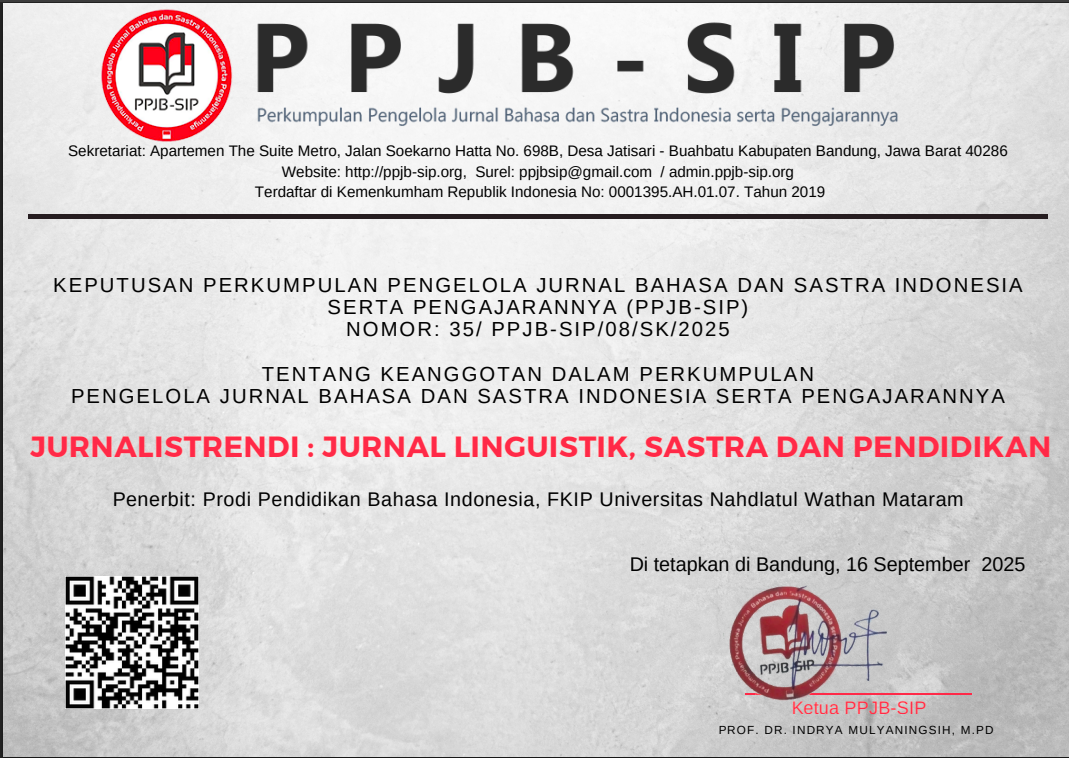Figurative Language in Taylor Swift’s Song Lyrics “All Too Well" in a 10-Minute Version
Abstract
The purposes of this research to find the types of figurative language and to uncover the types of meaning used in the ten minutes song lyrics by Taylor Swift. The research method used is qualitative descriptive method and to collect the data needed, the library research is implemented. The main theories used in this research are the theory of figurative language by Kennedy (1979) and of meaning types by Leech (1981). The result of the research shows respectively that there are 29 data of figurative language found in the lyrics of Taylor Swifts’ song comprising of 10 data (34.5%) on metaphor, 6 data (20.7%) on personification, 5 data (17.2%) on simile, 2 data (6.9%) on symbol, 2 data (6.9%) on hyperbole), 3 data (10.3%) on irony, 1 data (3.5%) on metonymy, but no data (0%) on allision; whereas the data on types of meaning found in the lyrics of Taylor Swifts’ song are 18 data (65.5%) on connotative meaning, 8 data (24.2%) on affective meaning and 3 data (10.3%) on conceptual meaning. The figurative language metaphor (34.5%) and connotative meaning (24.2%) become the most dominant due to the fact that Swift invites the listener to interpret and feel the emotions more intensely, creating a more immersive and evocative listening experience. Other than that, the song lyrics describe the feeling of how painful after breakup and severe betrayal.
Downloads
References
Azizah Ikhsani, N. (2012). Code Mixing In TheArticles Of Gogirl! Magazine February, 2013 Edition (Vol. 1, Issue 3).
Chandra, A., Ningrum, K., & Harida, R. (2021). Code Switching In Teaching Narrative For Junior High School. In Ratri Harida 44 Salience Journal (Vol. 1, Issue 1).
Dinillah Harya, T. (2018). Sociolinguistics (Code: Code Switching And Code Mixing). http://jurnal.stkippgribl.ac.id/index.php/lentera
Eka Putri, D., Sutjiati Djohan, R., & Endang Purwaningsih, D. (2016). A Study Of Code Mixing In English Novel Entitled “Crazy Rich Asians” By Kevin Kwan. In Jurnal Ilmiah Sastra (Vol. 4, Issue 1).
Herdian, P. A., & Supri, I. Z. (2020). English Journal Literacy Utama Language Styles Of Advertisement In Fast Food Company Slogans: Sociolinguistic Study. https://doi.org/10.33197/ejlutama.vol5.iss2.2020.2655.4585
Herman, H., Thao, N. Van, Purba, R., & Simanjuntak, N. S. U. (2022). Attracting Viewers through Advertisement by Using Code Mixing: A Sociolinguistics Study. Anglophile Journal, 2(2), 80. https://doi.org/10.51278/anglophile.v2i2.304
Hoffmann, C. (1991). An introduction to Bilingualism. In Introduction to Bilingualism. https://doi.org/10.4324/9781315842035
Holmes, & Janet. (1994). An Introduction to Sociolinguistics.
Kusumayanthi, S. (2022). The effect of peer feedbacks on students’ speech. English Journal Literacy UTama, 7(1). https://doi.org/10.33197/ejlutama.vol7.iss1.2021.2655.4585
Larassati, D., & Suyudi, I. (2021). English-indonesian code mixing found in the summer triangle novel by hara hope. Journal of Language and Literature, 9(2), 118–134. https://doi.org/10.35760/jll.2021.v9i2.5278
Luke, J. Y. (2015). The Use Of Code-Mixing Among Pamonanese In Parata Ndaya Closed-Group Facebook The Use of Code-Mixing .... (Joice Yulinda Luke). In Jurnal LINGUA CULTURA (Vol. 9, Issue 1).
Muysken, P. (2000). Bilingual speech : a typology of code-mixing. Cambridge University Press.
Myers-Scotton, C. (2007). Carol Myers-Scotton: Multiple Voices: An Introduction to Bilingualism. Applied Linguistics, 28. https://doi.org/citeulike-article-id:1208237
Mariani, N., Fatchul Mu’in & Yusuf Al Arief. (2019). An Introduction to Linguistics. Banjarmasin: Jurusan PBS FKIP Universitas Lambung Mangkurat.
Wardhaugh, R. (2006). An Introduction to Sociolinguistics.
Simatupang, E. C. M., & Amalia, S. (2019). A Sociolinguistic Study on Code Switching Among Overseas Indonesian Students on Facebook Comments.
Simatupang, E. C., Fadhilah, N. N., & Barokah, R. A. (2021). Pragmatic Analysis Of Deixis In The Novel Fangirl By Rainbow Rowell. English Journal Literacy UTama, 6(1). https://doi.org/10.33197/ejlutama.vol6.iss1.2021.2655.4585

.jpg)





